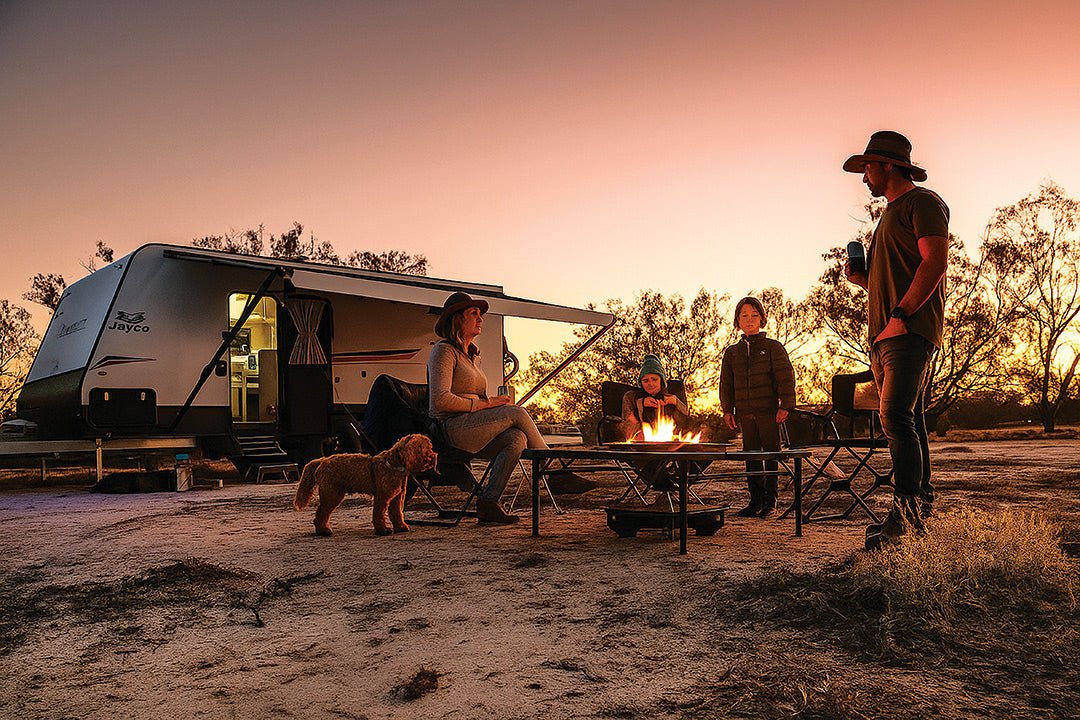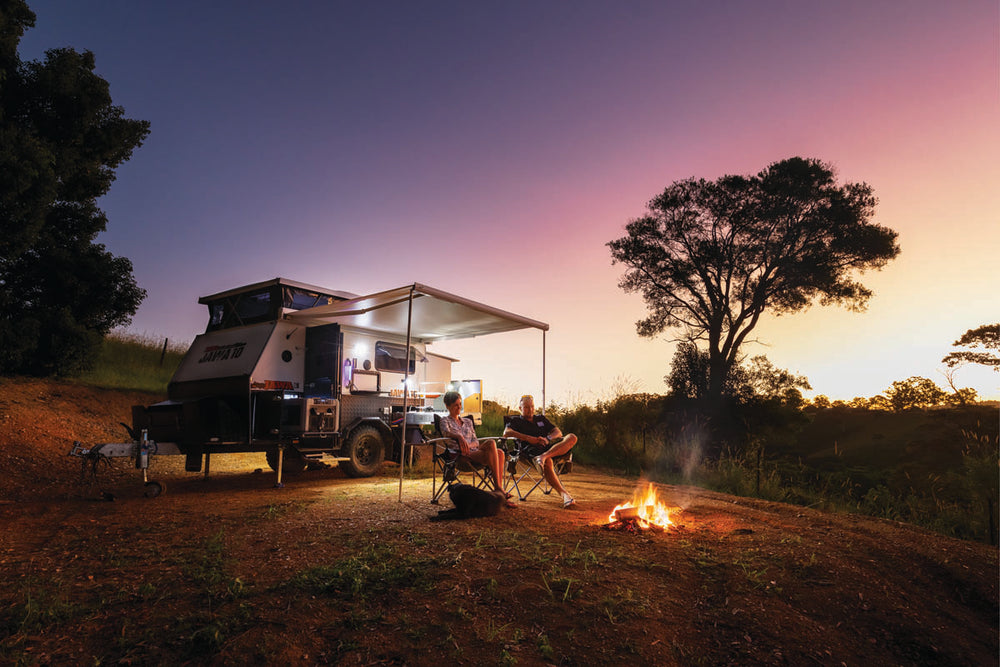

Bring your van and enjoy the true outback experience at Carinya Station (Image @theblondenomads)
Fossick for opals, stargaze in the evenings, soak in a hot artesian bore or explore quirky local pubs — there’s plenty to see and do in the iconic opal town of Lightning Ridge in outback New South Wales during the cooler months.
Cool, quiet mornings, mild days with clear blue skies and nights made for stargazing — late winter and early spring bring ideal conditions to Lightning Ridge in northern NSW.
One of the biggest drawcards to this iconic outback town is the free artesian bore baths, open around the clock. Arrive early to soak in the warm 40-degree waters as the rising sun filters through the mist or return at dusk to watch the sunset give way to a star-filled sky.
About Lightning Ridge
Tucked away in the rugged outback of NSW, Lightning Ridge is a small town world-famous for its rare and dazzling black opals. Since the discovery of this unique gem in 1901, the town has drawn miners, gem hunters and curious travellers alike.
Prized for their dark base and vibrant shifting colours, black opals quickly became sought after, setting Lightning Ridge on its path as a global opal hub. By 1915, more than 3000 people had settled in the area, adapting to harsh outback conditions with resilience.
Today, opal mining remains the heart of the town’s economy. Every opal is naturally mined, cut and polished without treatments — making each stone one of a kind and, in some cases, more valuable than diamonds, fetching up to $35,000 per carat.
 Lightning Ridge Bore Baths (Image #amandamundell)
Lightning Ridge Bore Baths (Image #amandamundell)
What to do in Lightning Ridge
Try your luck at noodling
One of Lightning Ridge’s most iconic activities is noodling — also known as fossicking — for opals. Whether you’re at the Visitor Information Centre in town, certain caravan parks, local attractions or out among the bush pubs near the Grawin opal fields, there are plenty of places to sift through opal tailings for a colourful keepsake. Because miners focus on efficiency and volume, it’s not unusual for overlooked gems to be hiding in the discarded mullock. Between April and October, the cooler weather makes it the perfect time to roll up your sleeves and see what treasures you might find in the sunbaked clay and sandstone.
Stargazing
For stunning sunset views and night skies, head to Nettleton’s First Shaft Lookout at the end of the Green Car Door tour. Set on an escarpment, it’s the perfect spot to watch the sun dip below the horizon and stay to see the stars emerge. With minimal light pollution and only the occasional hum from a nearby mining camp, the skies here are spectacular so bring your camera!
From April to September, the Australian Opal Centre hosts its ‘SPARK’ outdoor cinema nights at the nearby Three Mile Opal Fields — a chance to enjoy a film beneath the brilliant glow of the Milky Way.
 The sandstone maze at Nettleton’s First Shaft Lookout is a great attraction (Image Peter Chaffey Photography)
The sandstone maze at Nettleton’s First Shaft Lookout is a great attraction (Image Peter Chaffey Photography)
Flora and fauna
Lightning Ridge is home to a wide variety of native and introduced birdlife, including emus, cockatoos, willie wagtails, diamond doves, honeyeaters and the colourful Australian ringneck.
Despite the semi-arid climate, more than 50 native plant species thrive in the area’s tough clay and gravel soils.
A standout stop for nature lovers is Bevan’s Cactus Nursery — one of the largest cactus nurseries in the southern hemisphere. Established in 1966, this family-run nursery features around 2500 cacti varieties from across the globe. Some specimens are now more than 100 years old, with the oldest nearing 150 years.
Local drives and day trips
There are numerous easy day trips fanning out from your base at Lightning Ridge.
Head 70km north along the Castlereagh Highway to the historic border town of Hebel. The Hebel Hotel, established in 1894 as a Cobb & Co changing station, offers a classic outback pub experience with cold drinks and friendly locals.
North-west of Lightning Ridge, Culgoa National Park makes for a peaceful, off-the-beaten-track adventure and is a must-do for birdwatchers when the rivers are flowing. A 4WD or high-clearance vehicle is recommended for the park, and it’s wise to check road conditions before setting out. The route to the park passes through the historic town of Goodooga, which sits beside the Bokhara River — a picturesque spot for fishing, picnics or birdwatching. The town’s new Great Artesian Bore Baths were opened only a couple of years ago and provide the perfect excuse for a warm soak in mineral-rich water.
About two hours south-west, Brewarrina is home to the ancient Brewarrina Aboriginal Fish Traps, also known as Baiame’s Ngunnhu. Set in the Barwon River, these extraordinary stone structures are more than 40,000 years old and among the oldest human-made structures in the world.
Upcoming events in Lightning Ridge
If you’re heading to Lightning Ridge in coming months there’s a couple of local events that are worth checking out.
From 13–16 October 2025, the Peter Williams Black Opal Classic will take over the local bowling club. First held in 1996, the lawn bowls tournament draws teams from across the east coast, South Australia, New Zealand and even Norfolk Island. With $50,000 in prize money on offer, it’s a big-ticket event on the regional bowls calendar — and the custom shirts designed each year by legendary local outback artist John Murray have become collectibles in their own right.
Then there’s the wild and wonderful Potch Queen competition, happening on Saturday 1 November 2025. A staple of outback humour, this adults-only drag contest sees rugged local miners and brave visitors compete for the crown in true Ridge style. Keep an eye on Facebook for updates and tickets — it usually sells out fast.
 Watch the sun rise or set through the mist at Lightning Ridge’s Artesian Bore Baths (Image @twominutepostcards)
Watch the sun rise or set through the mist at Lightning Ridge’s Artesian Bore Baths (Image @twominutepostcards)
Getting to Lightning Ridge
The journey into outback NSW is part of the adventure.
Lightning Ridge sits roughly 720km northwest of Sydney (or 750km from Canberra) via the Great Western Highway over the Blue Mountains, then along the Castlereagh Highway through Mudgee, Coonamble and Walgett.
From Melbourne, it’s around 1200km — about a 14-hour drive — following the Hume, Newell and Castlereagh highways straight up through the heart of inland New South Wales.
Where to stay with your caravan
One of the perks of visiting Lightning Ridge during the cooler, drier months is that road access is usually easier — especially to caravan parks and stations with unsealed tracks. If it has rained recently, check with the accommodation provider on local road conditions.
Caravanners are well looked after, with a variety of caravan parks and farm stays to choose from, including:
- BIG4 Opal Holiday Park
- Carinya Station Farm Stay
- Crocodile Caravan Park
- Lightning Ridge Holiday Park
- Lightning Ridge Outback Resort and Caravan Park
- Lorne Station Caravan Park
If you’re travelling without the van, there’s a good mix of stays to suit different budgets and travel styles.
A gem of a destination
Whether you’re chasing gems, sunsets or a warm soak under the stars, Lightning Ridge offers a true taste of the outback — especially in the milder months of the year. For more inspiration and trip planning tips, head to the Lightning Ridge website.
THE NEXT STEP
If you want to learn the latest caravan news, find the most innovative new caravans and camping gear or get inspired to plan your next adventure to some of Australia’s best holiday destinations, subscribe to our weekly newsletter. We promise to send you only the best content.
Related articles:
Lightning Ridge Opal & Gem Festival: Opals, outback and so much more
Caravanning road trip: Gilgandra to Lightning Ridge, NSW
Australia’s best hot springs, thermal pools and artesian bores







